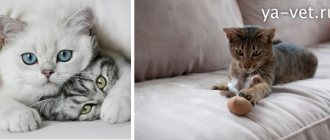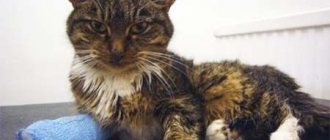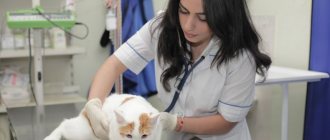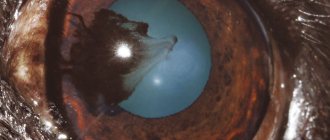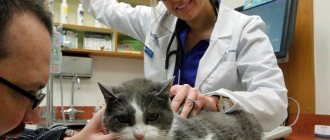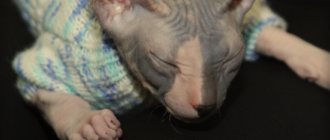When a pet has health problems, the first thing the cat is sent for tests, including a urine test. This study is carried out without fail; this analysis is required if kidney pathologies are suspected. Urine collection can be carried out in a veterinary clinic by a veterinarian, or the owner can independently collect urine from the pet. In the future, it will need to be taken for laboratory analysis. In this article we will introduce you in more detail to the indicators that are present in a urine test.
Physical indicators
Quantity
In cats, almost 70% of all liquid consumed is excreted in urine. The daily dose of urine in a cat will depend on the following aspects: the functioning of the genitourinary system, the functioning of the sweat glands, the composition of the feed, as well as the functioning of the kidneys and gastrointestinal tract. Normally, an adult cat produces 20-30 milliliters of urine in 24 hours.
An experienced veterinarian will be able to detect the presence of certain diseases based on the volume of urine.
Color
The color of urine can determine not only the presence of pathologies, but also what the cat eats and what medications it takes. The normal color of urine is yellow and all shades of yellow.
Specific gravity
This indicator is also called specific gravity, it shows how much solids are dissolved in the urine. This indicator can vary greatly during the day, as it depends on the functioning of individual organs, as well as on food.
In cats, the average specific gravity is 1.020 1.035 grams/l. If the indicator is slightly too high, this may indicate dehydration of the cat’s body. If the density is significantly lower than normal, this indicates the development of renal failure or other pathologies.
Precipitation, transparency
If sediment or visible flakes are found in the cat’s urine, then most likely there are inflammatory processes in the body. With laboratory analysis, specialists will be able to identify the source of these sediments.
Urine in the room should be completely clear. To check its transparency, you can pour it into a narrow flask, and attach a magazine or newspaper to the other side. If you can read the text without any problems, then everything is fine with the clarity of your pet’s urine.
Smell
The normal smell of urine in furry cats is specific and not strong. The smell may differ from the norm, and this mainly happens for the following reasons:
- Rot. If your pet's urine smells rotten, then most likely there are several areas of rot in the urinary tract. In this case, you should immediately contact a veterinarian.
- Acetone. Many cat owners know that if the urine has a strong smell of acetone, it means the cat has diabetes. In rare cases, this symptom may indicate another pathology - ketosis.
- Ether. This smell indicates that your pet has become infected with roundworms. The diagnosis is not 100%, so it is necessary to undergo examination at a veterinary clinic.
- Ammonia. If after going to the toilet you smell ammonia from the litter box, then you need to urgently take the cat to the hospital. Since in 90% of cases such a symptom indicates inflammation of the bladder.
- Cal. The smell of feces can indicate only one pathology - paraproctitis.
Reaction
The reaction of urine is determined by acidity, this indicator is measured in pH units. The reaction in cats is considered slightly acidic, since they eat mainly meat products. In the morning this indicator will be very low, and maximum after eating.
The pH environment is also checked for various pathologies and during treatment, since in this way it is possible to monitor the effectiveness of treatment.
Consistency
Normally, urine in cats should be liquid, that is, it will flow like water from one container to another.
With pathologies associated with the kidneys, the consistency may become jelly-like or even jelly-like. If you find such abnormalities in your furry, you should immediately take him to see a veterinarian.
Cat urine
We know that a cat's nature is to be a hunter, so it marks its territory to see who's in charge.
There are many situations in which a cat can use urine to sign the space in which it moves:
- The male does this when he senses the presence of a male cat in heat, obviously both of them are not sterilized: in this way he releases sex pheromones to attract the female cat;
- When he senses the presence of strangers: his urine mark indicates that he does not want them on his territory;
- The cat is in a state of severe stress: a calm environment in the house, the loss of the owner, the appearance of new animals or a child, a change of home.
However, usually the cat performs its physiological function by choosing a place to urinate: sometimes it does not coincide with the litter box, and a number of mechanisms must be put in place to teach him to use it.
© shutterstock
A cat's feline nature also comes into play when she pees: she digs deep and then covers it up, all solely so that the victim does not smell her and can escape.
Without interfering too much with his cat's lifestyle, we should observe the cat even when he is fulfilling his needs to understand whether he is healthy or if there are any problems.
It is also important to pay attention to the cat's behavior during urination, in addition to its color, noting if:
- the cat no longer pees;
- feels the urge but struggles to pee;
- despite the fact that he has been trained to use the litter box, he anxiously looks for a corner where he can do this;
- he makes strange noises while trying to shrink;
- since he cannot write, he refuses to eat;
- he is restless.
These are already alarm bells that force us to contact the veterinarian: based on what we noticed by observing the cat and analyzing his urine, the veterinarian will be able to better explain the situation.
Chemical indicators
Glucose
Normally, glucose should not be present in the urine. But this sometimes happens, for example, if the cat is experiencing anxiety and stress or has diabetes.
Protein
Protein is not found in urine because it is formed during the process of cellular breakdown. If protein is found in the urine, then most likely this is a pathology; sometimes this happens due to severe hypothermia. Kidney failure, cystitis, inflammation of the bladder, pyelonephritis, cystitis, diabetes mellitus. All of the previously listed diseases can lead to protein entering the urine.
Ketone bodies
Ketone bodies are acetone, as well as some acids, which are actively produced by the pet’s body during fasting or stress. Determining the presence of ketone bodies is quite simple, since the urine will smell strongly of acetone.
Bile pigments
Urobilinogen and bilirubin are the main bile pigments and are produced by the liver. Based on their number, we can talk about how the liver functions. If the number of pigments increases sharply, this indicates that the body is being poisoned by toxins. Sometimes the level of pigments increases due to inflammation of the bile ducts.
Hemoglobin
In a healthy state, cats do not contain hemoglobin in their urine; it is formed only if the cat is severely intoxicated. They can occur due to the ingestion of poisons into the body (lead, arsenic, poison of insects and other animals). In such a situation, hemoglobin is formed during the breakdown of red blood cells, and then it ends up in the urine. The presence of hemoglobin can be detected by the dark brown color of the urine.
Red blood cells
When red blood cells enter urine, it acquires a reddish tint. This is considered a deviation because the urine should not contain red blood cells. In 70% of cases, the entry of red blood cells into the urine indicates injury to the urinary system.
Nitrites
If nitrites are present in the urine, it means your pet has caught an infection somewhere and it has entered the urinary tract. A detailed blood and urine test will help identify the infection that has entered your cat's body.
Classification of kidney diseases
Based on the location of the primary pathological process, kidney diseases are divided into:
- Primary.
- Secondary.
The first group includes diseases in which the pathological process began directly in the kidneys. The second group included kidney damage as a result of hypertension, diabetes, and diseases of the genitourinary system.
According to the nature of the disease, the following are distinguished:
- Acute;
- Chronic.
In addition, congenital and acquired diseases are distinguished. Congenital - the result of genetic disorders in certain breeds of cats. The risk group includes Somali, Persian, Abyssinian and Himalayan breeds.
Crystalline precipitation
Sperm
During catheterization, a small amount of sperm may be released into the urine. There is no deviation in this; all this data can be seen on the overall final analysis table.
Epithelial cells
The urine may contain a small amount of flat cells; the content of other cells is already considered a deviation from the norm.
Fat
In general, there should be no fat in the urine, but if a drop of fat is found in the daily dose of urine, then this is not a pathology. But if there is much more fat, then this indicates a metabolic disorder in the pet. In this case, treatment at a veterinary clinic is required.
Leukocytes
At 400x magnification, 0 to 3 cells should be visible on the microscope. If there are more of them, then such a deviation is called leukocyturia, and if their number exceeds 50, then pyuria. This type of urine is dark brown in color and smells like pus.
Urinary cylinders
Normally, urinary casts should not be present in urine. If such a deviation is observed, this indicates that the urine is too alkaline. Therefore, it is able to flush out the urinary ducts.
Vitamin C
By the amount of vitamin C, you can determine how things are with vitamins in the cat’s body. A daily dose of urine contains approximately 50 mg of vitamin C.
Bacteria
If the cat is healthy, then the urine should be sterile. If bacteria are present, it means there is inflammation in the genitourinary system.
Slime
Mucus in urine is contained in small doses. Its amount can increase during inflammatory processes in the body.
Mushrooms
Sometimes cats may have yeast in their urine when tested. They can enter the body along with anticancer drugs.
Possible variations in color and redness of urine
Most often, the color of urine changes from straw to deep yellow. As a rule, this does not threaten the pet with anything bad. This shade may indicate a mild degree of dehydration, accompanied by severe thirst. This often happens if a cat has been walking for a long time in the summer without access to water. Just give your pet something to drink and everything will be fine. It often happens that a sterilized cat has dark urine. After surgery, this is also a normal phenomenon, since before surgery the animal was probably kept on a starvation diet, and it most likely did not receive a lot of water.
How to collect urine for analysis?
Owners mainly use the following urine collection methods:
- Remove the litter from the tray and wash it with detergent. Wait until your pet comes to relieve itself, and then drain the urine into a sterile container.
- Sometimes cats are capricious and therefore refuse to go to the litter box without litter. In this case, you can put several paper napkins. When your cat goes to the toilet, squeeze out a small amount of urine into a container.
- If you are unable to take your cat’s urine for analysis, then contact a veterinary clinic. Experienced veterinarians will definitely be able to take a sample for research.
Try to have your urine analyzed at least once a quarter, as this way you can identify pathologies at the development stage.
Prevention of kidney diseases
General preventive measures:
- Proper care and comfortable maintenance of your pet.
- Avoiding hypothermia of the animal.
- Providing a balanced diet for your cat.
- Preventing falls from heights.
- Preventing the animal from walking on its own.
- Vaccination according to the vaccination schedule.
- Compliance with drinking regime.
- Water quality control.
- Organization of proper nutrition.
- Regular preventive examinations with a veterinarian.
Postoperative period and other options
When urine looks like tomato juice after sterilization, there is also a reason for conscious panic. There is a possibility of serious internal bleeding, so the veterinarian should be notified immediately. Let’s immediately make a reservation that urine with blood immediately after surgery (any) is a completely normal phenomenon, and you should not tear your hair out. You only need to worry when the urine is constantly red, and the color becomes more saturated with each act of urination.
If we touch on the topic of surgical interventions, we cannot help but talk about the effect of various medications on the color of urine. Thus, medications based on nitrofurans, which are often used to treat cystitis and other pathologies of the urinary system, give the animal’s secretions a lemon or rich yellow color. This is normal, no need to worry.
In addition, urine may change color under the influence of antibiotics, while taking anticancer drugs and some laxatives, after Pirantel. It is important to remember that after completing a course of medication, urine should acquire its natural yellowish color within one and a half to two days maximum. If this does not happen, there is every reason to suspect something is wrong, since the treatment was clearly not the cause of the color change.
The worst thing is when the urine takes on the appearance of a “bloody slop” or, as they say in veterinary reference books, becomes like “meat slop”. This indicates severe cases of pyelonephritis or glomerulonephritis. If you don’t take your cat to the vet right away, he probably won’t be able to live long.
Also a bad (very bad) sign is green or greenish-yellow color of the discharge. This indicates severe damage to the liver parenchyma, which causes the so-called parenchymal jaundice. However, in this case, this pathology can safely be called “greenback”. Such an interesting color is explained by the presence of pure bilirubin in the urine. If your cat's discharge turns green, take him to the vet immediately, as parenchymal jaundice is fraught with severe neuropathic seizures and death. How else can urine be colored?
Perhaps dark brown urine is one of the most alarming signs . Often he talks about the presence of a serious blood parasitic infection or leptospirosis.
Treatment of chronic renal failure
Treatment of the disease in cats, regardless of the stage of the disease, is supportive. A cure is unattainable, the disease can only be slowed down. Cats live with chronic renal failure for a certain period. Its duration depends on many factors:
- At what point did intensive treatment begin?
- What is the age of the pet - old animals and small kittens are difficult to tolerate the disease;
- What is the general immunity of the animal;
- How does the owner feel about the health of the cat, etc.
Rules for preparing for analysis
If the veterinarian has prescribed a urine test, you must take measures for the collection and delivery of the test material to maintain the reliability of the result:
- The cat's tray needs to be washed well and doused with boiling water. Urine can be collected from a tray, although it is advisable to immediately collect it in the container in which the analysis will be sent to the laboratory.
- As a container, you can use a sterile syringe or jar, or a special container.
- The test material must be delivered to the clinic within 30 minutes after collection. If this cannot be done, the urine should be cooled to 4°C and sent to the laboratory within 4 hours.
- A urine test in a dog will be most accurate if the material is collected directly when the animal urinates.
